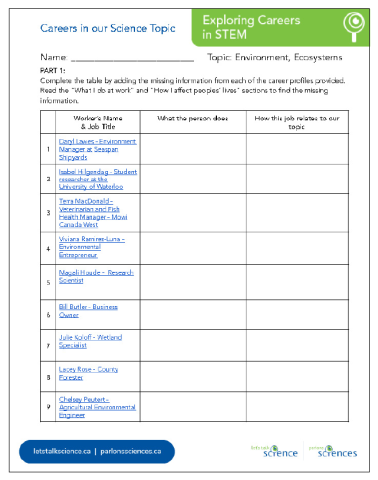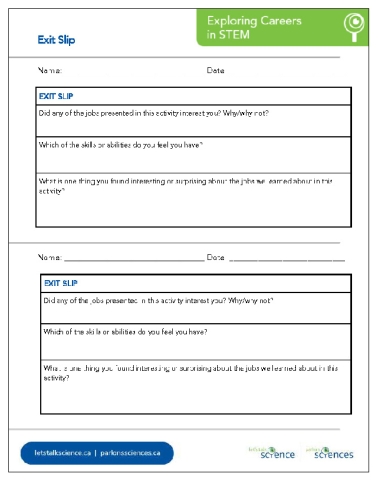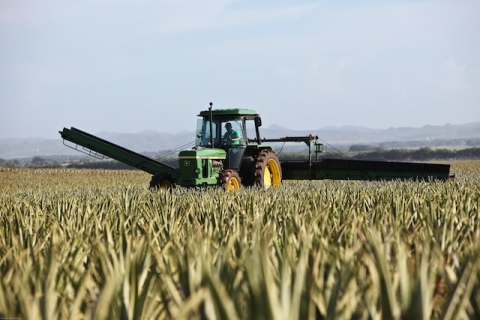Exploring Careers in STEM Grade 7

Person working at laptop (Christina Morillo, unsplash)

Person working at laptop (Christina Morillo, unsplash)
How does this align with my curriculum?
| Grade | Course | Topic |
|---|
Students will expand their knowledge of STEM career types related to a topic they are studying in science.
Overview
| Activities | Timing | Student Grouping | Description |
|---|---|---|---|
| Minds-On: These are the Jobs we Know | 10-15 minutes | Individual, small and large group | Students brainstorm as many jobs as they can which are related to the science topic they are studying. |
| Action: Exploring Jobs in STEM | 30-50 minutes | Small group | Students use collections of career profiles to explore careers related to the science topic they are studying. |
| Consolidation: What we Learned About STEM Careers | 10-15 minutes | Independent | Students demonstrate what they have learned about STEM careers. |
This lesson can be used as a concluding activity at the end of each unit in this course.
Students will:
- Explore the variety of careers found in STEM workplaces
- Explore real world examples of various careers
- Learn about skills and abilities that are useful in the workplace
Learning Goals
Students will:
- Explore the variety of careers found in STEM workplaces
- Explore real world examples of various careers
- Learn about skills and abilities that are useful in the workplace
Students can:
- List examples of STEM careers related to the science topic they are studying
- Recognize the variety of careers that relate to a specific topic of study
- Identify skills and abilities that are useful in the workplace
Success Criteria
Students can:
- List examples of STEM careers related to the science topic they are studying
- Recognize the variety of careers that relate to a specific topic of study
- Identify skills and abilities that are useful in the workplace
This icon indicates potential assessment opportunities.
Observations
- Take note of the numbers and types of jobs students list for the topic they are studying (Minds-On).
- Observe student contributions as they discuss the STEM jobs related to the topic they are studying (Action).
Conversations
- Have conversations with students about the beliefs they may have about the STEM jobs related to the topic they are studying (Action).
- Listen to students as they share what they have learned from their completion of the Exploring Careers in STEM reproducible (Action).
Products
- Review the Exploring Careers in STEM reproducible for accuracy (Action).
- Review the Exploring Careers in STEM Exit Slip for appropriate responses (Consolidation).
Evidence of Student Learning
This icon indicates potential assessment opportunities.
Observations
- Take note of the numbers and types of jobs students list for the topic they are studying (Minds-On).
- Observe student contributions as they discuss the STEM jobs related to the topic they are studying (Action).
Conversations
- Have conversations with students about the beliefs they may have about the STEM jobs related to the topic they are studying (Action).
- Listen to students as they share what they have learned from their completion of the Exploring Careers in STEM reproducible (Action).
Products
- Review the Exploring Careers in STEM reproducible for accuracy (Action).
- Review the Exploring Careers in STEM Exit Slip for appropriate responses (Consolidation).
Students will:
- Explore the variety of careers found in STEM workplaces
- Explore real world examples of various careers
- Learn about skills and abilities that are useful in the workplace
Learning Goals
Students will:
- Explore the variety of careers found in STEM workplaces
- Explore real world examples of various careers
- Learn about skills and abilities that are useful in the workplace
Students can:
- List examples of STEM careers related to the science topic they are studying
- Recognize the variety of careers that relate to a specific topic of study
- Identify skills and abilities that are useful in the workplace
Success Criteria
Students can:
- List examples of STEM careers related to the science topic they are studying
- Recognize the variety of careers that relate to a specific topic of study
- Identify skills and abilities that are useful in the workplace
This icon indicates potential assessment opportunities.
Observations
- Take note of the numbers and types of jobs students list for the topic they are studying (Minds-On).
- Observe student contributions as they discuss the STEM jobs related to the topic they are studying (Action).
Conversations
- Have conversations with students about the beliefs they may have about the STEM jobs related to the topic they are studying (Action).
- Listen to students as they share what they have learned from their completion of the Exploring Careers in STEM reproducible (Action).
Products
- Review the Exploring Careers in STEM reproducible for accuracy (Action).
- Review the Exploring Careers in STEM Exit Slip for appropriate responses (Consolidation).
Evidence of Student Learning
This icon indicates potential assessment opportunities.
Observations
- Take note of the numbers and types of jobs students list for the topic they are studying (Minds-On).
- Observe student contributions as they discuss the STEM jobs related to the topic they are studying (Action).
Conversations
- Have conversations with students about the beliefs they may have about the STEM jobs related to the topic they are studying (Action).
- Listen to students as they share what they have learned from their completion of the Exploring Careers in STEM reproducible (Action).
Products
- Review the Exploring Careers in STEM reproducible for accuracy (Action).
- Review the Exploring Careers in STEM Exit Slip for appropriate responses (Consolidation).
Materials and Preparation
| Material/Technology/Setting | Quantity |
|---|---|
|
1 per group |
|
1 per student |
|
For teacher use |
Materials
| Material/Technology/Setting | Quantity |
|---|---|
|
1 per group |
|
1 per student |
|
For teacher use |
- This lesson will work best after students have completed a topic or complete unit of study (i.e., after they have learned about habitats or ecosystems; after the unit on Heat has been addressed).
- Where possible during the unit, mention a couple of jobs that are related to the topic.
- Choose one of the Exploring Careers in STEM reproducibles to focus on.
- Book access to web-enabled digital devices for students (if necessary).
- Set up computer and projector.
Preparation
- This lesson will work best after students have completed a topic or complete unit of study (i.e., after they have learned about habitats or ecosystems; after the unit on Heat has been addressed).
- Where possible during the unit, mention a couple of jobs that are related to the topic.
- Choose one of the Exploring Careers in STEM reproducibles to focus on.
- Book access to web-enabled digital devices for students (if necessary).
- Set up computer and projector.
- Knowledge of a specific Grade 7 science topic
Student Prior Knowledge and Skills
- Knowledge of a specific Grade 7 science topic
| Material/Technology/Setting | Quantity |
|---|---|
|
1 per group |
|
1 per student |
|
For teacher use |
Materials
| Material/Technology/Setting | Quantity |
|---|---|
|
1 per group |
|
1 per student |
|
For teacher use |
- This lesson will work best after students have completed a topic or complete unit of study (i.e., after they have learned about habitats or ecosystems; after the unit on Heat has been addressed).
- Where possible during the unit, mention a couple of jobs that are related to the topic.
- Choose one of the Exploring Careers in STEM reproducibles to focus on.
- Book access to web-enabled digital devices for students (if necessary).
- Set up computer and projector.
Preparation
- This lesson will work best after students have completed a topic or complete unit of study (i.e., after they have learned about habitats or ecosystems; after the unit on Heat has been addressed).
- Where possible during the unit, mention a couple of jobs that are related to the topic.
- Choose one of the Exploring Careers in STEM reproducibles to focus on.
- Book access to web-enabled digital devices for students (if necessary).
- Set up computer and projector.
- Knowledge of a specific Grade 7 science topic
Student Prior Knowledge and Skills
- Knowledge of a specific Grade 7 science topic
Teaching and Learning Activities
This icon indicates potential assessment opportunities
Minds-On: These are the Jobs we Know (10 - 15 min.)
| Instructions | Teaching Tips |
|---|---|
|
Jog students’ memories of the topic/unit they just completed by naming various activities, examples, concepts, etc., discussed in class. Provide each student with a copy of The Jobs People Do reproducible [Google doc] [Word doc] [PDF]. 
Engage students in a think-pair-share to activate and build their knowledge about the careers or jobs related to the topic they have been studying in science. Have students use the reproducible for gathering their ideas. |
DiscussionsPrompt students for whole class sharing with such questions as:
IdeaIf students find it difficult to think of an appropriate career or job, or if a limited number of jobs are suggested, supply some examples from your experience. |
|
Ask for volunteers to verbally share their pair’s list with the class. As students name the various jobs, record these on the board, chart paper or digitally. If possible, provide titles for jobs that were described (i.e., if a student said “this person checks how well you can hear sounds” you could add “audiologist” to the list). |
LanguageYou may wish to post the list of job titles in multiple languages. Additionally, you can provide images of people doing these jobs. |
Action: Exploring Careers in STEM (30 - 50 min.)
| Instructions | Teaching Tips |
|---|---|
|
Tell students that in this part of this lesson they are going to look at some real jobs, related to a topic they have studied, and the people who do them. Refer back to the list of jobs they came up with and point out that there are many types of jobs associated with the topic they have learned about. Some of these jobs are well known and often seen in movies, TV shows, commercials, etc. (e.g., when we think of people who work on a farm, we often think of the farmer). Some are less well known. |
|
|
Provide each student with one of the Exploring Careers in STEM reproducibles. 
|
|
|
Direct students to read the “What I do at work” and “How I affect peoples’ lives” sections of the career profiles. This will provide them with necessary information to complete Part 1 (the table). After students have completed the table, ask for volunteers to share their thoughts on how the different jobs are related to the topic they are studying or the things they are doing in class. Where necessary, ask students to clarify their thoughts, perhaps by giving an example from the profile. |
TechnologyIf students do not have access to internet-enabled devices, you could project the Let’s Talk Science career site on a screen and work through several profiles together as a class. Alternatively, you could print off copies of the profiles for students to read. These could be posted in different locations or stations around the room with students moving from location to location. TechnologyIf students are working from a hard copy of the reproducible, direct them to the Let’s Talk Science career resource and have them search for the worker’s name using the search box (top right). IdeaStudents could pair up to work on Part 1 of the activity. |
|
When the table has been completed, direct students to complete Part 2. This should be done as an individual activity. Upon completion, pair students and have partners take turns sharing items from their lists. Using the lists they created, students should discuss and select three skills or abilities they feel are most important for workers in this area. Have each pair join with another pair to form a quad and share their top three skills or abilities. In their group, discuss the importance of these six skills and come to an agreement on the top two skills or abilities from their list. |
IdeaThis is a good opportunity to help students clarify what constitutes a job in STEM (Science, Technology, Engineering and Math). |
|
When the quad groups have selected their two skills, lead a whole class discussion in which each group shares the skills or abilities they felt were most important. Ask students to explain why they chose the skills or abilities that they did. As students present their group’s top two skills, record these on the board, chart paper or digitally. Using a show of hands, have students vote to create a class list of the top two skills for working in this area. To conclude this part of the lesson, clarify with students that all the skills they listed are important. Which skills are most important will vary from job to job and even situation to situation. The important thing is that they do their best to develop a well-rounded set of skills that they can draw from as they progress through school and enter the workforce. Explore and discuss any questions or comments students may have. |
DiscussionsDiscussion prompts can include:
|
Consolidation: What we Learned About STEM Careers (5 - 10 min.)
| Instructions | Teaching Tips |
|---|---|
|
To conclude, have students complete the Exploring Careers in STEM Exit Slip reproducible [Google doc] [Word doc] [PDF]. 
|
If time is tight, the Exit Slip could be completed outside of class time. |
Background Information for Teachers
Why Exposing Students to Various STEM Careers is Important
Students often have a limited understanding of the breadth of jobs people do. For example, when thinking about agriculture, students may think only of farmers, and not of the other people who work in this sector.

Image - Text Version
Shown is a colour photograph of a farmer's field with a tractor in the middle of it.
The camera is in the field, among the crops. Spiky, pale green leaves are close-up and out of focus in the foreground. A flat field of the same plants stretches to a strip of dark trees at the horizon.
In the centre, the focus of the image is a green tractor with large yellow wheels and thick black tires. Two long, dark beam-shaped structures extend from the vehicle. One at the front, angled up, and the other across the back, along the top of the crops. Above, the sky is hazy and blueish grey.
In reality, many workers have specialized roles that are related to a broad category. Within agriculture for example, there are mechanics and engineers who develop and repair farm equipment. There are also scientists and technicians who test soil, develop fertilizers and pesticides, and who protect wildlife from harmful chemicals used on the farm. All have a role to play in the success of a farming enterprise. Exposing students to a variety of careers related to the topics they are studying broadens their horizons of careers and activities they can aspire to in the future. It also helps them see the purpose of schooling.
Ultimately, if they don’t know the careers that are available, they cannot prepare for them!

Image - Text Version
Shown is a person crouched on one knee, with both hands around a small plant in the ground, in a field of similar plants.
The person has long red hair in a ponytail, hanging over one shoulder. Their face is covered with a green and white baseball cap. They are wearing a purple sleeveless top and reaching down to touch the ground with both hands.
In the background, beyond the field, is a mix of deciduous and coniferous trees. The sky above is pale blue and clear.
Additional Resources
Reproducibles
- The Jobs People Do reproducible [Google doc] [Word doc] [PDF]
- Choice of:
- Exploring Careers in STEM: Environment and Ecosystems reproducible [Google doc] [Word doc] [PDF]
- Exploring Careers in STEM: Pure Substances and Mixtures Career Areas reproducible [Google doc] [Word doc] [PDF]
- Exploring Careers in STEM: Heat, Energy and Climate Change reproducible [Google doc] [Word doc] [PDF]
- Exploring Careers in STEM: Form, Function & Design of Structures reproducible [Google doc] [Word doc] [PDF]
- Exploring Careers in STEM: Rocks, Minerals & Earth’s Crust reproducible [Google doc] [Word doc] [PDF]
- Exploring Careers in STEM Exit Slip reproducible [Google doc] [Word doc] [PDF]
- Answer Keys:
- Exploring Careers in STEM (Environment and Ecosystems) reproducible [Google doc] [Word doc] [PDF]
- Exploring Careers in STEM (Pure Substances and Mixtures) reproducible [Google doc] [Word doc] [PDF]
- Exploring Careers in STEM (Heat ) reproducible [Google doc] [Word doc] [PDF]
- Exploring Careers in STEM (Structures: Form, Function, Design) reproducible [Google doc] [Word doc] [PDF]
- Exploring Careers in STEM (Rocks and Minerals in the Earth’s Crust) reproducible [Google doc] [Word doc] [PDF]
Videos
SciTrends - STEM Careers (2017)
This collection of 6 videos describe STEM careers in wearable technology, automated vehicles, robotics, drones and water treatment.
What do you want to do? STEM Careers (2012)
Using animations, this 2:35 min video from England, shares the variety of careers that have a STEM connection.
Reproducibles and Media
Reproducibles
- The Jobs People Do reproducible [Google doc] [Word doc] [PDF]
- Choice of:
- Exploring Careers in STEM: Environment and Ecosystems reproducible [Google doc] [Word doc] [PDF]
- Exploring Careers in STEM: Pure Substances and Mixtures Career Areas reproducible [Google doc] [Word doc] [PDF]
- Exploring Careers in STEM: Heat, Energy and Climate Change reproducible [Google doc] [Word doc] [PDF]
- Exploring Careers in STEM: Form, Function & Design of Structures reproducible [Google doc] [Word doc] [PDF]
- Exploring Careers in STEM: Rocks, Minerals & Earth’s Crust reproducible [Google doc] [Word doc] [PDF]
- Exploring Careers in STEM Exit Slip reproducible [Google doc] [Word doc] [PDF]
- Answer Keys:
- Exploring Careers in STEM (Environment and Ecosystems) reproducible [Google doc] [Word doc] [PDF]
- Exploring Careers in STEM (Pure Substances and Mixtures) reproducible [Google doc] [Word doc] [PDF]
- Exploring Careers in STEM (Heat ) reproducible [Google doc] [Word doc] [PDF]
- Exploring Careers in STEM (Structures: Form, Function, Design) reproducible [Google doc] [Word doc] [PDF]
- Exploring Careers in STEM (Rocks and Minerals in the Earth’s Crust) reproducible [Google doc] [Word doc] [PDF]
Videos
SciTrends - STEM Careers (2017)
This collection of 6 videos describe STEM careers in wearable technology, automated vehicles, robotics, drones and water treatment.
What do you want to do? STEM Careers (2012)
Using animations, this 2:35 min video from England, shares the variety of careers that have a STEM connection.
Science
- For selected science topics, students could map out how what they study in school is related to what someone does in their job. For example, learning about ecosystems leads to learning more about ecology in high school, which leads to getting an Environmental Technician’s certification which leads to doing water analysis to protect fish from pollution.
- Students could design and conduct a survey to determine the variety of STEM careers students in their school are aware of.
Literacy
- Students could create a written description of the different types of STEM careers related to the topic they are studying.
- Students could research a job they learned about in one of the career profiles and create an informational poster or advertisement.
- Students could create a short play, rant, song, rap, etc., that communicates the variety of STEM careers related to a topic they have studied.
- Students could write a “help wanted” advertisement for a job related to this topic.
Computational Thinking
- Students could explore how computational thinking is involved in a STEM career of their choice.
Visual Arts
- Students could create a poster or collage to depict one or more STEM careers related to the topic they are studying.
Extensions
Science
- For selected science topics, students could map out how what they study in school is related to what someone does in their job. For example, learning about ecosystems leads to learning more about ecology in high school, which leads to getting an Environmental Technician’s certification which leads to doing water analysis to protect fish from pollution.
- Students could design and conduct a survey to determine the variety of STEM careers students in their school are aware of.
Literacy
- Students could create a written description of the different types of STEM careers related to the topic they are studying.
- Students could research a job they learned about in one of the career profiles and create an informational poster or advertisement.
- Students could create a short play, rant, song, rap, etc., that communicates the variety of STEM careers related to a topic they have studied.
- Students could write a “help wanted” advertisement for a job related to this topic.
Computational Thinking
- Students could explore how computational thinking is involved in a STEM career of their choice.
Visual Arts
- Students could create a poster or collage to depict one or more STEM careers related to the topic they are studying.
The high cost of dropping math and science
Outlines the implications for youth who drop out of math and science in high school.
What do Canada’s teens think about their futures?
Explores the motivational factors that influence young peoples’ plans for the future.
Learn More
The high cost of dropping math and science
Outlines the implications for youth who drop out of math and science in high school.
What do Canada’s teens think about their futures?
Explores the motivational factors that influence young peoples’ plans for the future.
Reproducibles
- The Jobs People Do reproducible [Google doc] [Word doc] [PDF]
- Choice of:
- Exploring Careers in STEM: Environment and Ecosystems reproducible [Google doc] [Word doc] [PDF]
- Exploring Careers in STEM: Pure Substances and Mixtures Career Areas reproducible [Google doc] [Word doc] [PDF]
- Exploring Careers in STEM: Heat, Energy and Climate Change reproducible [Google doc] [Word doc] [PDF]
- Exploring Careers in STEM: Form, Function & Design of Structures reproducible [Google doc] [Word doc] [PDF]
- Exploring Careers in STEM: Rocks, Minerals & Earth’s Crust reproducible [Google doc] [Word doc] [PDF]
- Exploring Careers in STEM Exit Slip reproducible [Google doc] [Word doc] [PDF]
- Answer Keys:
- Exploring Careers in STEM (Environment and Ecosystems) reproducible [Google doc] [Word doc] [PDF]
- Exploring Careers in STEM (Pure Substances and Mixtures) reproducible [Google doc] [Word doc] [PDF]
- Exploring Careers in STEM (Heat ) reproducible [Google doc] [Word doc] [PDF]
- Exploring Careers in STEM (Structures: Form, Function, Design) reproducible [Google doc] [Word doc] [PDF]
- Exploring Careers in STEM (Rocks and Minerals in the Earth’s Crust) reproducible [Google doc] [Word doc] [PDF]
Videos
SciTrends - STEM Careers (2017)
This collection of 6 videos describe STEM careers in wearable technology, automated vehicles, robotics, drones and water treatment.
What do you want to do? STEM Careers (2012)
Using animations, this 2:35 min video from England, shares the variety of careers that have a STEM connection.
Reproducibles and Media
Reproducibles
- The Jobs People Do reproducible [Google doc] [Word doc] [PDF]
- Choice of:
- Exploring Careers in STEM: Environment and Ecosystems reproducible [Google doc] [Word doc] [PDF]
- Exploring Careers in STEM: Pure Substances and Mixtures Career Areas reproducible [Google doc] [Word doc] [PDF]
- Exploring Careers in STEM: Heat, Energy and Climate Change reproducible [Google doc] [Word doc] [PDF]
- Exploring Careers in STEM: Form, Function & Design of Structures reproducible [Google doc] [Word doc] [PDF]
- Exploring Careers in STEM: Rocks, Minerals & Earth’s Crust reproducible [Google doc] [Word doc] [PDF]
- Exploring Careers in STEM Exit Slip reproducible [Google doc] [Word doc] [PDF]
- Answer Keys:
- Exploring Careers in STEM (Environment and Ecosystems) reproducible [Google doc] [Word doc] [PDF]
- Exploring Careers in STEM (Pure Substances and Mixtures) reproducible [Google doc] [Word doc] [PDF]
- Exploring Careers in STEM (Heat ) reproducible [Google doc] [Word doc] [PDF]
- Exploring Careers in STEM (Structures: Form, Function, Design) reproducible [Google doc] [Word doc] [PDF]
- Exploring Careers in STEM (Rocks and Minerals in the Earth’s Crust) reproducible [Google doc] [Word doc] [PDF]
Videos
SciTrends - STEM Careers (2017)
This collection of 6 videos describe STEM careers in wearable technology, automated vehicles, robotics, drones and water treatment.
What do you want to do? STEM Careers (2012)
Using animations, this 2:35 min video from England, shares the variety of careers that have a STEM connection.
Science
- For selected science topics, students could map out how what they study in school is related to what someone does in their job. For example, learning about ecosystems leads to learning more about ecology in high school, which leads to getting an Environmental Technician’s certification which leads to doing water analysis to protect fish from pollution.
- Students could design and conduct a survey to determine the variety of STEM careers students in their school are aware of.
Literacy
- Students could create a written description of the different types of STEM careers related to the topic they are studying.
- Students could research a job they learned about in one of the career profiles and create an informational poster or advertisement.
- Students could create a short play, rant, song, rap, etc., that communicates the variety of STEM careers related to a topic they have studied.
- Students could write a “help wanted” advertisement for a job related to this topic.
Computational Thinking
- Students could explore how computational thinking is involved in a STEM career of their choice.
Visual Arts
- Students could create a poster or collage to depict one or more STEM careers related to the topic they are studying.
Extensions
Science
- For selected science topics, students could map out how what they study in school is related to what someone does in their job. For example, learning about ecosystems leads to learning more about ecology in high school, which leads to getting an Environmental Technician’s certification which leads to doing water analysis to protect fish from pollution.
- Students could design and conduct a survey to determine the variety of STEM careers students in their school are aware of.
Literacy
- Students could create a written description of the different types of STEM careers related to the topic they are studying.
- Students could research a job they learned about in one of the career profiles and create an informational poster or advertisement.
- Students could create a short play, rant, song, rap, etc., that communicates the variety of STEM careers related to a topic they have studied.
- Students could write a “help wanted” advertisement for a job related to this topic.
Computational Thinking
- Students could explore how computational thinking is involved in a STEM career of their choice.
Visual Arts
- Students could create a poster or collage to depict one or more STEM careers related to the topic they are studying.
The high cost of dropping math and science
Outlines the implications for youth who drop out of math and science in high school.
What do Canada’s teens think about their futures?
Explores the motivational factors that influence young peoples’ plans for the future.
Learn More
The high cost of dropping math and science
Outlines the implications for youth who drop out of math and science in high school.
What do Canada’s teens think about their futures?
Explores the motivational factors that influence young peoples’ plans for the future.